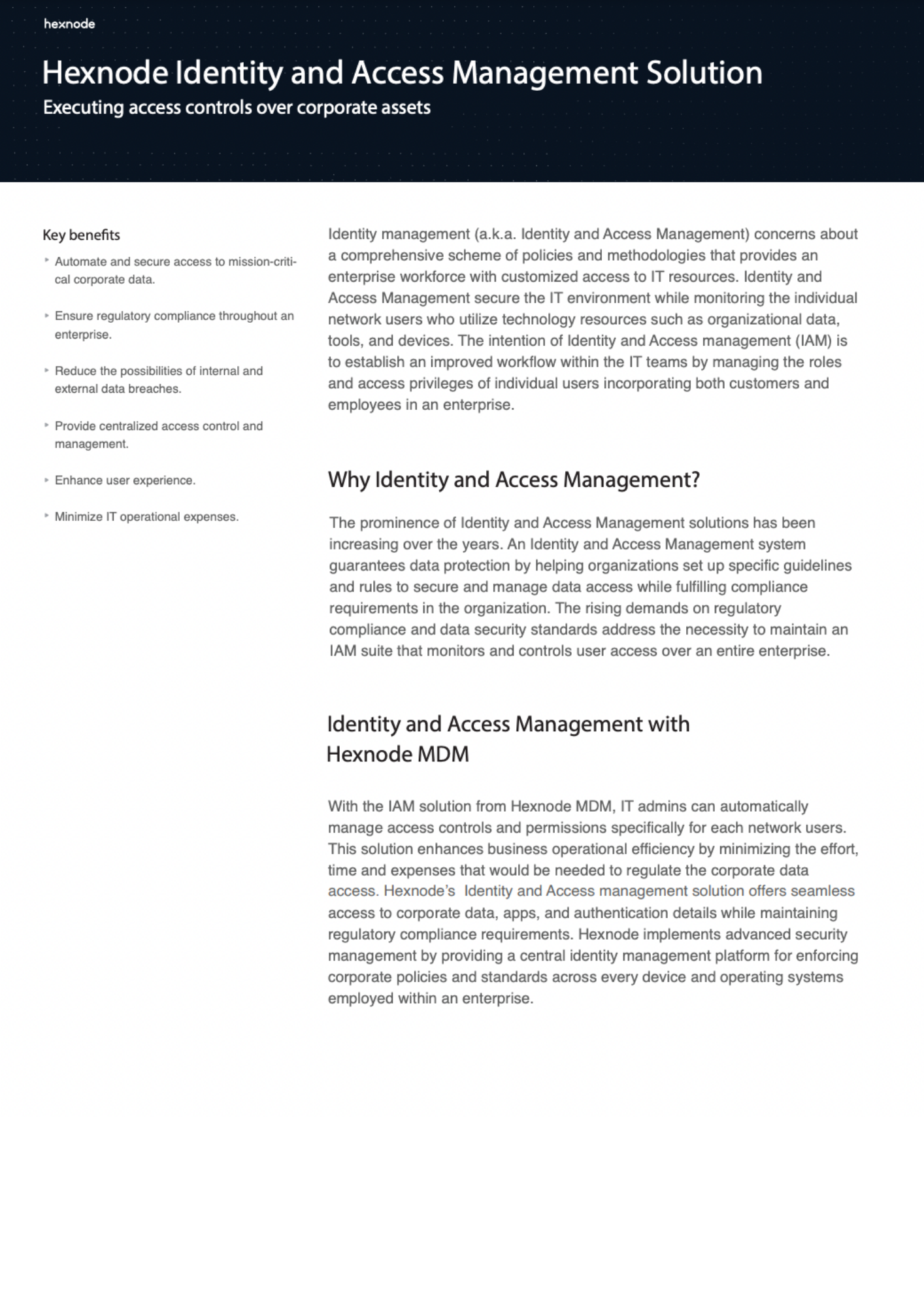It’s been a year since National Cybersecurity Alliance and the Identity Defined Security Alliance (IDSA), hosted the first ‘Identity Management Day’ and ever since the 2nd Tuesday of April is known as Identity Management Day. As the world rapidly shifts to a complete digitalization, it is important to acknowledge the growing digital security threats and maintain healthy cyber hygiene.
When it comes to cyber security you often find yourself plugging holes in response to new compliance mandates or a recent data breach. Integrating identity and access management (IAM) infrastructure with security solutions allows enterprises to access and interact with enterprise networks in a variety of ways.
Enterprises can limit the risk of both intrusions and lateral movement of attackers already within the network by using an identity-centric strategy.

Featured resource
Hexnode IAM datasheet
The prominence of Identity and Access Management solutions has been increasing over the years. Download this datasheet to know more about IAM.
Download datasheetImportance of Identity
Identity is the fundamental link between users, devices, and cloud applications. Companies must evolve from a reactive approach to their security protocol. A preventive approach is a well-rounded method since it focuses on avoiding the cyber attack.
With identity theft, the thief gets access to multiple key features like installing and removing software. This allows the attacker to modify, configure applications and gain access to sensitive assets.
Identity is widely known to incorporate a focus on enabling the five A’s :
1. Authentication
Verifying if the users are who they are claiming to be.
2. Authorization
Determining if the individuals are authorized to access the systems.
3. Access to data
Checking the data individuals have access to and the actions they are allowed to take relative to that data.
4. Audit policies
Ensuring that policies are put in place to verify the identity of the user. IT admins should audit and verify the working of these policies.
5. Accountability
In case of a breach, the reason must be immediately diagnosed and the personnel responsible for it must immediately be held accountable.
Where information architecture takes a hit:
Easy Access:
Users tend to prefer easier tools for access and often, the easiest tools of all don’t necessarily have the best security measures and hurt your digital security policy.
Lack of Vigilance:
Data is exchanged every day through corporate servers, and a data breach can prove to be fatal as many corporates do not have the capabilities to even detect the loss of data.
Response time gap:
When users are given new security tools or an updated OS, they tend to take a lot of time to learn their work and can often end up badly.
Maintain security
Identity-centric security does not advocate for an identity-only approach to security. Data security, application security, and network security are all critical components for complete digital security. This approach, on the other hand, considers identity security as a critical component of IT security.
Corporates should grow past the reactive framework of security and implement new techniques of Zero-trust security model.
Zero trust security
The basic idea behind zero trust is to presume that everything is unsafe by default. The older architecture relied on approved IP addresses, ports, and protocols to establish access controls and validate what’s trusted inside the network. This generally means that a user can easily gain access to the network by connecting to a VPN.
In contrast, Zero trust security trusts no network, despite the fact that the device is connected to an internal network.
Use case of Zero trust
- Zero trust’s main goal is to create an advanced access control system that authenticates users based on their identity, security posture, and other factors. Zero trust can provide granular degrees of security by blocking untrusted devices from accessing the organization’s resources using location or device-specific access control policies.
- Firewalls, for example, adopt a “passthrough” technique, checking files as they arrive. When a dangerous file is found, notifications are sometimes too late. In order for an inline proxy architecture to analyze all traffic and encrypted information in real-time, an effective zero trust solution terminates all connections.
- Users connect directly to the apps and resources they need with a zero-trust approach, never to networks. Hence, networks can be compromised, and a change is required in how we view local networks. A zero-trust approach between users and apps reduces the possibility of lateral movement and keeps infected devices from infecting other resources.
- If a breach does occur, it is vital to reduce the radius of the incident. An attacker’s scope of credentials or access pathways is limited by Zero Trust, which allows systems and people time to respond to the attack.
What is Zero Trust Network Access (ZTNA) and why is it the future of cloud network security?
Implementing zero trust:
In today’s world, cyber hygiene is just as important as regular hygiene, keeping your data safe requires monitoring and following safety protocols.
Password Hygiene:
Maintaining good password hygiene is necessary throughout the organization as one bad password can open up the network to multiple threats. An organization can take the help of software like Hexnode UEM to apply policies on password management. Having a unique and randomized password that is updated often is the best practice. When maintaining multiple accounts, it gets harder for the employees to remember multiple log-ins with different passwords. To preserve security, the ideal way would be to use a password-keeping tool that, securely encrypts and saves all the passwords for you.
Multifactor Authentication:
With MFA activated, the user has to go through more than one way of authenticating their ID before they are given access. This means the user has to authenticate using secondary verification methods like OTP, built-in biometrics, or external tools like google authenticator.
Access management:
Make sure the right personnel get access to the right resources. With Hexnode UEM you can make sure to push only the required resources to the user. This way the IT can be sure about who has access to what resource and helps in auditing and accountability.
Secure apps:
With a UEM like Hexnode, you can filter and allow access to apps that are deemed safe.
Analytics:
With Hexnode analytics you can constantly monitor the enrolled devices, right from their location, state, and compliance.
Is Zero Trust model the final frontier in enterprise security?
Conclusion
It is widely accepted that the best way to protect your enterprise is by deploying an Identity first approach. Having an active identity management protocol is a must for complete digital security.


